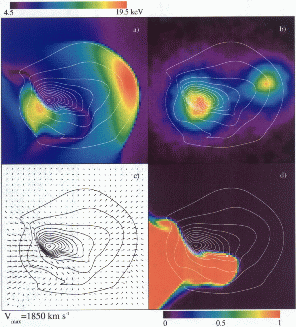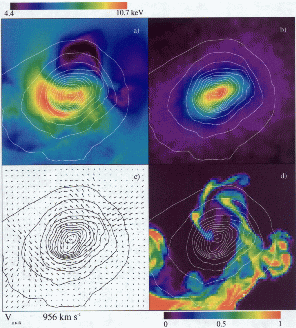

Clusters of galaxies formed late in the history of the Universe; in fact it appears some clusters are still growing through mergers. The hot, X-ray emitting, intergalactic medium trapped in the gravitational potential well of clusters is strongly affected by mergers. Strong shocks, rapid rotation, and turbulence are produced in the gas, all of which can be investigated through numerical simulation.
This work was done in collaboration with Kurt Roettiger (UMo) and Richard Mushotzky (GSFC).
The dynamics of merging clusters can be studied using an idealized problem: the collision of two spherical, self-gravitating clusters composed of both gas and collisionless dark matter. The images below show the evolution of the X-ray surface brightness and temperature (upper left), dark matter distribution (upper right), gas velocity (lower left), and a tracer quantity that labels the two clusters initially as red and black (lower right) in the off-axis collision of two clusters with a 5:2 mass ratio. The image on the left is made at 0.3Gyr after closest approach of the cluster cores, and the image on the right is made at 2.75Gyr after closest approach. Each image covers an area 2Mpc across. Click on either image to download a full-sized version.


Another important observable of clusters of galaxies is the effect the hot gas has on the spectrum of the CMB: the Sunyaev-Zeldovitch effect. By performing a large number of controlled experiments of cluster mergers with different parameters, a statistical limit can be places on the error introduced by assuming all clusters are round and isothermal, as opposed to triaxial and stratified as a result of mergers.
This study was led by Kurt Roettiger; more details are in his papers:
``Anatomy of a Merger: A Numerical Model of A754", by K. Roettiger, J.M. Stone, & R. Mushotzky, The Astrophysical Journal, 493, 62 (1998).

The image shows the log
gas density (left column), gas temperature (second column), and log
magnetic pressure (third column) in two-dimensional slices taken
through the cluster core in the plane of the merger. Each row
represents a different epoch. Row 1 is t=0, the time of core
coincidence. Rows 2, 3, and 4 represent t=1.3, 3.4, and 5.0 Gyr. Click
on the image to download a full-sized version.
The time-evolution of the total magnetic energy shows clear signs of field amplification, so that by the end of the evolution the combination of rotational and magnetic forces are enough to cause the average radial density and temperature profile to differ from strict hydrostatic equilibrium. However, even with a resolution of 512x256x256 grid points, more dynamic range is needed in the cluster core to study the field amplification there. On the other hand, these MHD cluster merger models can be used to model the non-thermal radio emission from merging clusters self-consistently.
More details can be found in the following papers:
``Magnetic Field Evolution in Merging Clusters of Galaxies", by K. Roettiger, J.M. Stone, & J.O. Burns, The Astrophysical Journal, 518, 594 (1999).